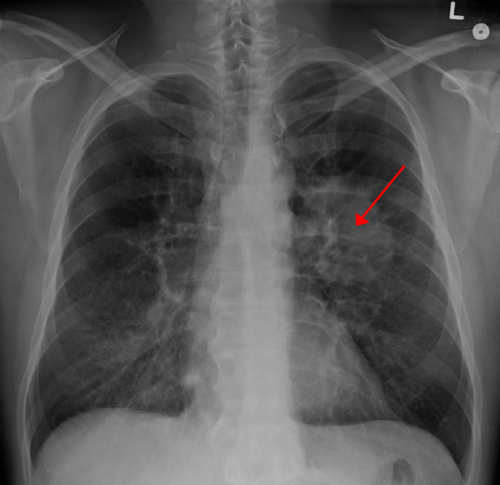Lung CA seen on CXR. Credit: CC BY-SA 4.0 James Heilman, MD/Wikipedia
Including smoking cessation with existing lung cancer screening efforts would reduce lung cancer mortality by 14 percent and increase life-years gained by 81 percent compared with screening alone, according to a study from Rafael Meza from the University of Michigan and colleagues and published in the Journal of Thoracic Oncology, a publication of the International Association for the Study of Lung Cancer.
Annual lung cancer screening with low-dose computed tomography (LDCT) is recommended for adults aged 55-80 with a greater than 30 pack-year smoking history who currently smoke or quit within the previous 15 years. Since about 50% of screen-eligible individuals are still current smokers, cessation interventions at the point of screening are recommended. However, information about the short- and long-term effects of joint screening and cessation interventions is limited.
Dr. Meza and colleagues from the University of Michigan and Georgetown University used an established lung cancer simulation model to project the impact of cessation interventions within the screening context on lung cancer and overall mortality for the 1950 and 1960 US birth-cohorts. Two million individual smoking and life histories were generated per cohort. Simulated individuals were screened annually according to current guidelines and different assumptions of screening uptake rates. Dr. Meza's team then simulated a cessation intervention at the time of the first screen, under a range of efficacy assumptions.
Point-of-screening cessation interventions would greatly reduce lung cancer mortality and delay overall deaths compared to screening alone. For example, under a 30% screening uptake scenario, adding a cessation intervention at the time of the first screen with a 10% success probability for the 1950 birth-cohort would further reduce lung cancer deaths by 14% and increase life-years gained by 81% compared with screening alone.
However, the actual gains are highly sensitive to the variation in screening uptake and cessation probability. Dr. Meza said that even mildly effective cessation interventions could greatly enhance the impact of LDCT screening programs. This is because cessation not only reduces the risk of lung cancer, but also would prevent other tobacco-related diseases such as chronic obstructive pulmonary disease (COPD) and cardiovascular disease. Ms. Pianpian Cao, the study's first author and a doctoral student at the University of Michigan, said that most of these great benefits won't be realized unless lung screening uptake is improved. So more work is needed to promote lung cancer screening and facilitate access, particularly for those at highest risk.
The researchers concluded that further evaluation of specific cessation interventions within lung screening, including costs and feasibility of implementation and dissemination, are needed to determine the best possible strategies and realize the full promise of lung cancer screening.
More information: Pianpian Cao et al, Potential Impact of Cessation Interventions at the Point of Lung Cancer Screening on Lung Cancer and Overall Mortality in the United States, Journal of Thoracic Oncology (2020). DOI: 10.1016/j.jtho.2020.02.008
Journal information: Journal of Thoracic Oncology
Provided by International Association for the Study of Lung Cancer























